Organza properties and its varieties

Organza is an amazing combination of airiness and beauty. It can be matte or shiny, of the same color or with an interesting ornament. Very stylish interior items, magnificent theatrical costumes and outfits for various events are obtained from it. The fabric is made from a variety of fibers or pure polyester. A distinctive feature of organza is its play and shine.
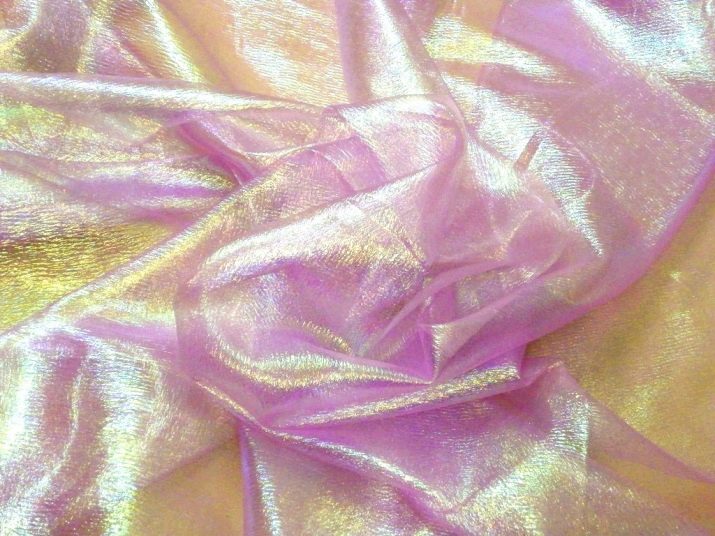
What it is?
Organza is a premium material. There are two versions regarding the history of its origin. According to one story, it originated in North America and was created by a well-known company that made materials from silk. According to another version, it began to be produced in the old Uzbek city, which was later renamed Organza.
Organza looks very presentable and beautiful, thanks to which it is very popular all over the world. Initially, only silk threads were used in the production of the material. This implied the high cost of the fabric and the possibility of its acquisition only by noble people. The production process for the material was very complex and costly. Workers were required to be highly skilled in order to obtain excellent quality yarns.
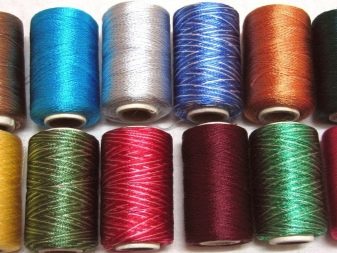

Due to the high cost, the material was used mainly as a decoration. Organza was used to decorate collars, cuffs, or to decorate evening dresses with it. The material became available thanks to the advent of synthetic fibers. Due to the inclusion of polyester threads, it was possible to preserve the original qualities of the fabric and make it more affordable.
As for the description of the fabric itself, it is a beautiful transparent material, a little tough and very strong.Despite its airiness, organza is very strong and dense. It perfectly retains its shape and practically does not wrinkle. With tactile contact, the fabric is very smooth and slightly cool.

Composition
The fabric currently contains 100% polyester. To make this type of fabric, the finest fibers are selected. They are incredibly airy and seem completely weightless. Due to the strong twisting of the threads, the material is quite tough.
Depending on the method of technological processing, you can get different types of material. Organza can be matte or shiny. Due to the use of transparent and faceted fibers, the material sparkles and shimmers in the light. The fabric can be marketed in plain color, with iridescent tints, or with various patterns.
The composition of the fabric can also include silk and viscose. Such organza will cost significantly more than a synthetic analogue.
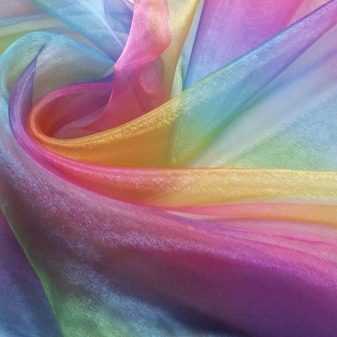

Properties
The main advantages of organza:
- practically does not wrinkle and no creases appear on the surface;
- due to its high wear resistance, the fabric is resistant to tears and other damage;
- has a high light transmittance;
- does not shrink or deform during long-term operation;
- retains its shape for a long time, this allows you to make persistent folds and textured draperies on products made of this material;
- has increased resistance to organic solvents;
- has a very beautiful and unusual appearance;
- the material is easy to care for and very durable.
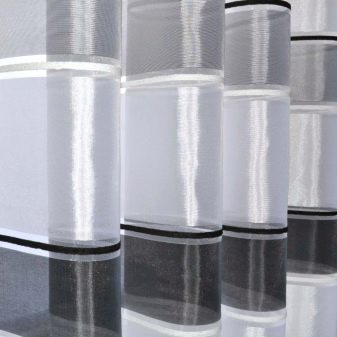
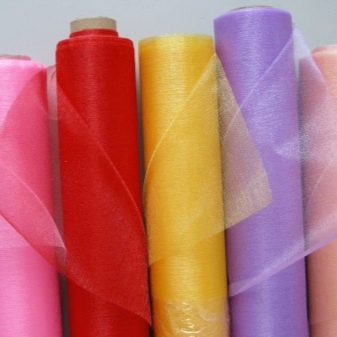
In addition to its undeniable advantages, the material also has a number of disadvantages.
- High-quality organza has a rather high cost.
- The fabric is a little prickly, and besides, it is transparent, so the organza clothes are lined.
- Matter does not allow air to pass through well.
- The fabric is quite difficult to cut and process. In the process of cutting, the matter slips strongly and spreads in different directions. Many professional tricks should be used to tailor products made from this fabric.
Before proceeding with the layout of the sketches and their cutting, the material should be ironed until the fabric is smooth.

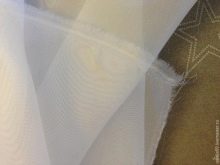
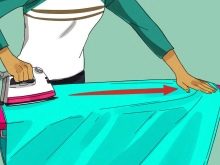
During the cutting process, the fabric slips strongly, therefore experts recommend using a special cotton or flannel mat. The organza should be attached to it with pins and only then begin to cut. The pattern should be translated using copy stitches. Copy paper or serrated scissors are not suitable for this type of fabric.
In the process of cutting, allowances are necessarily made. It is best if they are twice as large as for other fabrics. The edges of the fabric crumble a lot and it is better to sew them with a double stitch on an overlocker or a sewing machine with a “zigzag” mode.
In the process of folding the edge, place a sheet of paper under the fabric so that it does not slip. Smooth the seams very carefully. First, all the pins are removed, and then the fabric is placed on special paper. It is not recommended to press hard with the iron.
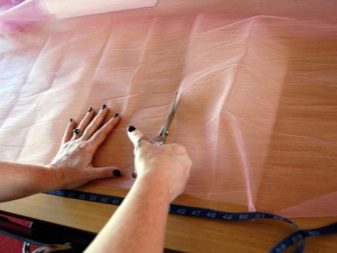
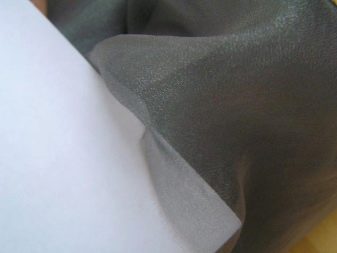
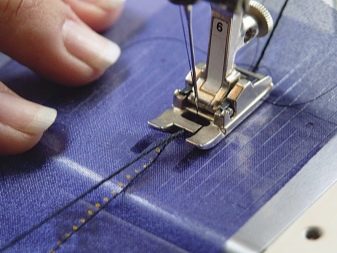
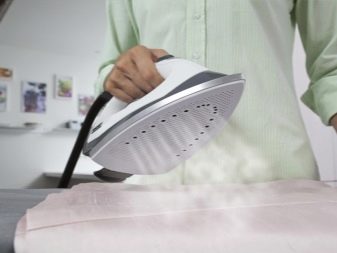
Ironing curtains from such fabric is not easy; it is best to do this while the fabric is still wet. For housewives who do not really like everyday difficulties, it is worth choosing curtains from an organza-reaper or fabric with a pattern. Then small flaws in the ironing process will become less obvious.
Experts do not recommend hanging curtains made of this fabric on the windows if they face the south or east side. Due to constant exposure to sunlight, the fabric can quickly fade and lose its spectacular appearance.
It is important to remember that polyester curtains can catch fire when heated, so it is best not to use synthetic organza curtains in the kitchen, where the stove is located near the window.
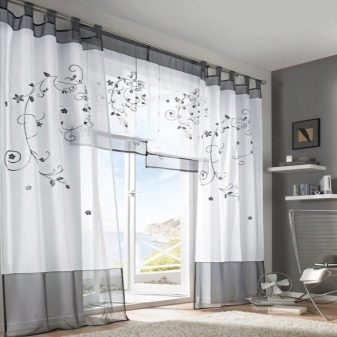

Views
Let's consider the main types of fabric.
- Organza chameleon compares favorably with analogs by a very effective play of color and shadow.At a certain angle of illumination, the fabric can acquire different shades of the base color. This effect is achieved by connecting threads of different tones.
- Reaper is a material with creases and wrinkles. Such a decorative effect is possible when using a special press during production.
- Spray material is an organza with a golden or silver tint. This material looks very elegant, thanks to the shining particles in the composition of the canvas.
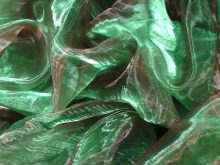
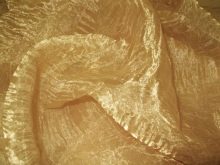
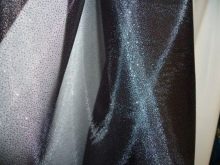
- Organza Crash looks very unusual and is similar in texture to broken glass.
- Jacquard decorated with large beautiful patterns.
- Aluminum fiber fabric characterized by strong gloss and incredible durability.
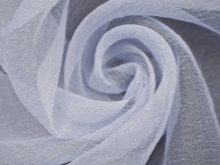
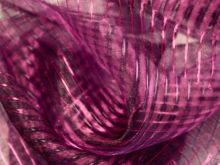
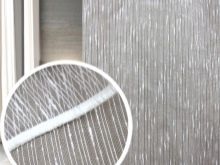
As for the design options for organza, there are several among the most popular.
- Embroidery. In the process of fabric production, threads of different colors are used, which form a decorative pattern. This type of material is considered the most expensive.
- Etching or burning the pattern on the material using chemical technologies. A special mixture is applied to the organza, which literally eats away at the cellulose. A small layer of mesh remains, which creates a full-fledged pattern or complements it. This type of decoration is typical for the material, which includes silk and viscose.
- Seal is a special method of decoration, when a multi-colored ornament is imprinted on the outside of the canvas.
- Laser cutting allows you to cut the smallest intricate patterns on the surface of organza.
- Punching the technique of execution resembles the previous version. With the help of vector graphics, a special pattern is created, then decorative cuts are made on the canvas.
What type of fabric to choose for sewing, each hostess decides for herself. Fabric with a pattern or decor requires less effort during ironing and washing.
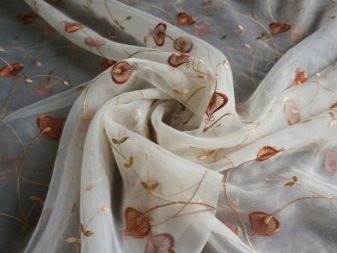
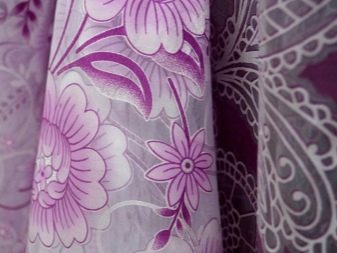

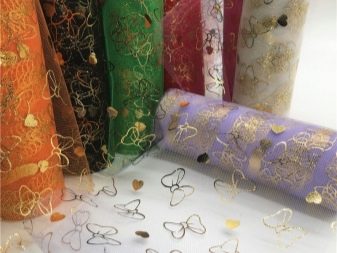
Where is it applied?
Consider the main options for using organza.
- Due to its transparency and lightness, the material is perfect for sewing curtains and curtains. Organza looks great in window openings. It lets in sunlight and fresh air, perfectly decorates any space and creates a feeling of lightness and festivity. Due to a wide selection of types and colors of fabric, curtains can be strict and laconic, or vice versa - catchy and effective. Organza can be used to sew a variety of types of curtains, for example, classic, Roman, with a lambrequin, etc.

- In addition to curtains and curtains, weightless canopies are sewn from organza for children's and adult beds, creating a cozy and romantic interior.

- Various stage costumes and evening dresses are made of organza. For evening wear, organza is often used as a decoration.
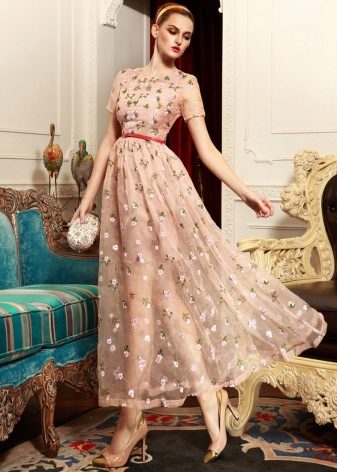
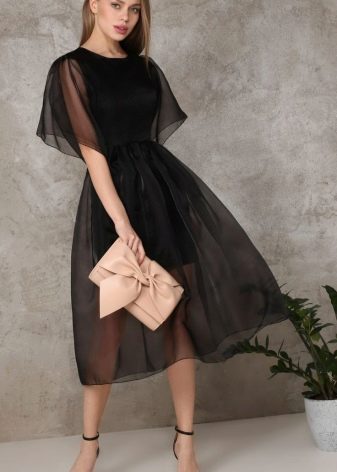
- Elegant blouses and light skirts are sewn from it.
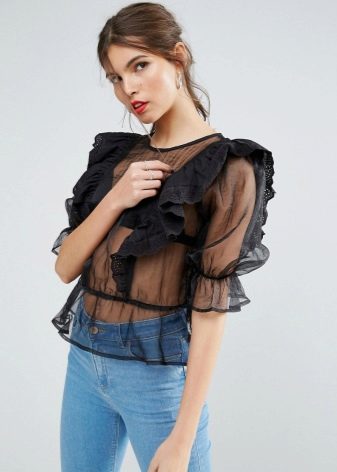

- Some needlewomen make original mascot trees from fabric.
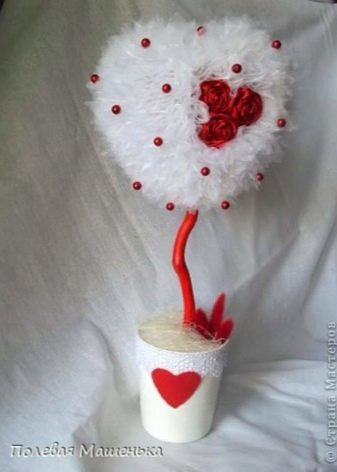
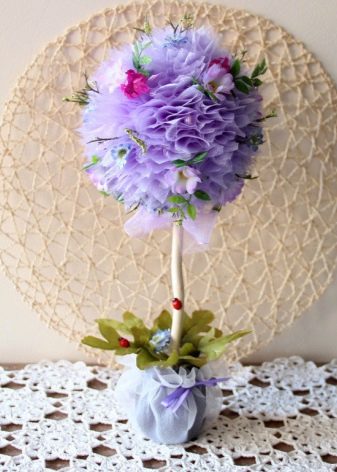
- Various organza decorations for flower arrangements are very popular.
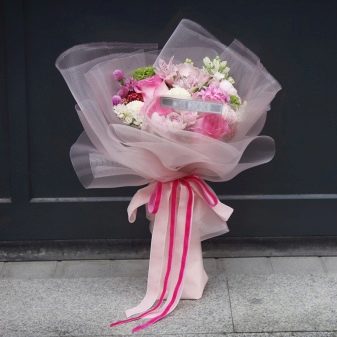

- The fabric is perfect for making school bows and various girls' hairpins.
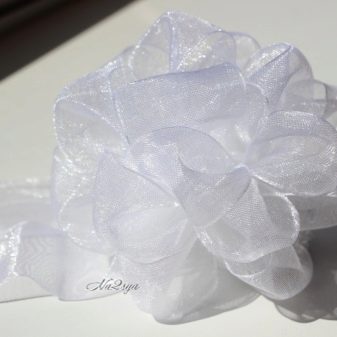
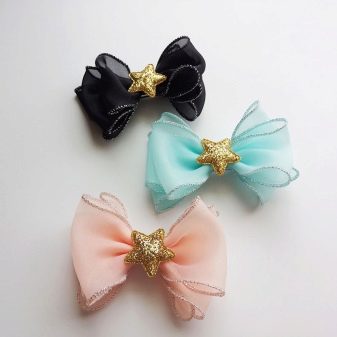
- The material is very popular when sewing gift bags and other packaging.

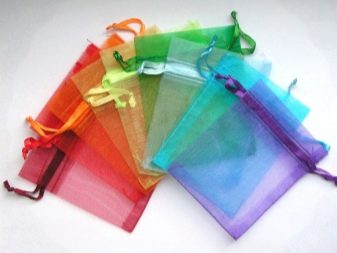
- Designers use fabric in the design of exhibition and banquet halls. Also, the material is widely used in the interiors of restaurants and hotels.

- Luxurious wedding dresses with a fluffy skirt made of organza are very popular.
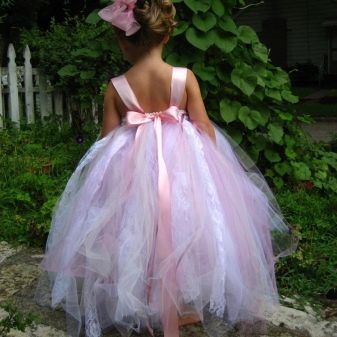
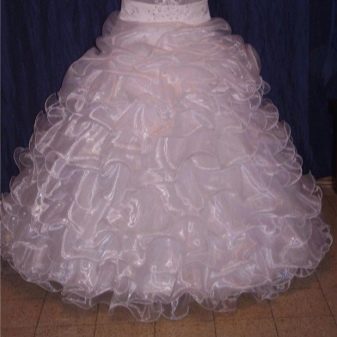
Subtleties of care
Organza is an extremely durable and practical material. Caring for her is simple, but has certain nuances.
- Clothes and other accessories made of this fabric can be machine washed. To do this, select the "delicate" wash program and the temperature regime not higher than 40 degrees.
- If organza products contain sequins, beads and other decorative elements, such things should be washed only by hand.
- Squeezing organza products in a typewriter should be at minimum speed.
- Liquid detergents can be used for this fabric.
- Do not use products containing chlorine.
After washing, all items must be shaken and hung dry. It is worth avoiding direct sunlight on the material so that the color does not fade too quickly.
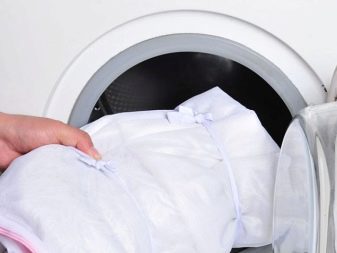
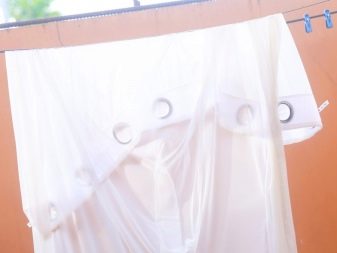
- It is better to straighten all things carefully, otherwise there will be great difficulties in smoothing out the creases in the future.
- Organza clothes and accessories should be ironed at the lowest temperature. This primarily applies to fabrics with a mixed composition. Ironing should be started when things are not yet completely dry. Better to use damp gauze or other cotton cloth. As a last resort, the use of blank paper is allowed.
- Organza, which contains silk and viscose, should be hand washed. Squeeze such material with your hands, having previously wrapped the product in a terry towel. It will absorb more water and, due to its structure, will soften the effect on the organza.
- Experts do not recommend ironing all-polyester fabrics. If, during storage, ugly creases appear on things or curtains made of organza, you should wash the products again and dry them flat. The force of gravity will straighten the creases and folds. It is also possible to use a steamer.
Before you start washing or ironing things made of this fabric, you should carefully study the information on the label. This will help extend the life of things and keep them intact for much longer.
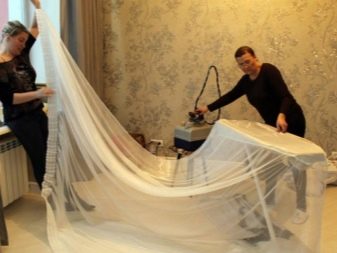

For what organza is and how it differs from a veil, see the next video.








